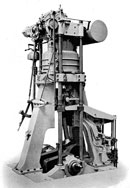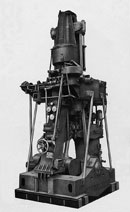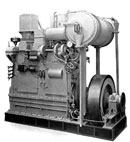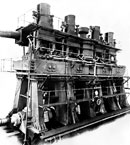|

KARL OTTO KELLER (1877-1942) 
1912 Piston Oil Engine
Experimental Unit.
Keller was a native of Switzerland born on March 21st 1877 at Zurich. In 1901 he qualified as a mechanical engineer. He came to England in 1903 and thereafter made this country his home. After appointments with Kynochs and Napiers, he was engaged by J.I. Thornycroft on the design of submarine engines. At that time attention was being given to the possibility of gas engine propulsion for ships, and it was for the purpose of investigating this method of propulsion that Doxfords first engaged him in 1905. After three years on this work Doxfords decided not to proceed with the idea. He then worked for William Reavell of Ipswich, before returning to Doxfords in 1911 as chief designer.

Doxford Opposed Piston Oil
Engine Demonstration
Doxfords had been experimenting on a single piston diesel unit for the past twelve months, this was later abandoned in favour of the opposed piston type. Working alongside the famous German engineer Professor Junkers, and with his assistant William Purdie, Keller started designing an engine of the opposed piston type in 1912. British Engineers frowned upon this system, as continental engines of this type had failed, however by 1914 a prototype was ready. It was a single-cylinder Opposed Piston Unit and was part of an engine developing 450 H.P. The cylinder bore was 500mm and it was to run at 130rpm.

Submarine Engine 400BHP
In June and July of 1914 the engine ran successfully for 35 days, watched by observers from Lloyds. Then the 1914-1918 war broke out and Doxfords made steam turbines for destroyers. A total of 21 Destroyers were built each, carrying a 27,000 H.P. on turbines and water-tube boilers amounting to 567,000 H.P. Also during these war years Keller developed a 400bhp low fuel consumption diesel engine for use in submarines. Four of these high-speed 360rpm units used together would occupy about the same machinery space as the turbines in the K class submarines but would give the same sea speed of 24 knots with about half the fuel consumption, this roughly doubling the radius of action. The end of the war brought 
YNGAREN Sea Trials
this project to an end, and it was not pursued further. It was after the war his inventive genius of the internal combustion engineering was successfully developed a four cylinder opposed piston Doxford engine which was first installed in the motor ship “Yngaren” (1921) and other vessels. In his early work Mr Keller was closely associated with Mr. Robert P 
First Doxford opposed
piston engine 1920.Doxford, together and with other members of the family. Mr. Keller 's inventions had to do with the constructional details of the engine and in the later designs with the use of welded structures in the engine bedplate and framing. These designs were built under licence by a number of other companies in this country, and also in the United States, by the Sun Shipbuilding Company.
It was computed that during the years Mr Keller was with the firm the aggregated horsepower of the engines constructed by Doxfords and licensees was in the order of 2,000,000 hp. The value of marine Diesel engines cannot be over estimated, and from a technical as well as a personal standpoint, the death of Karl Otto Keller in 1942 was a great loss to the marine engineering world.
|